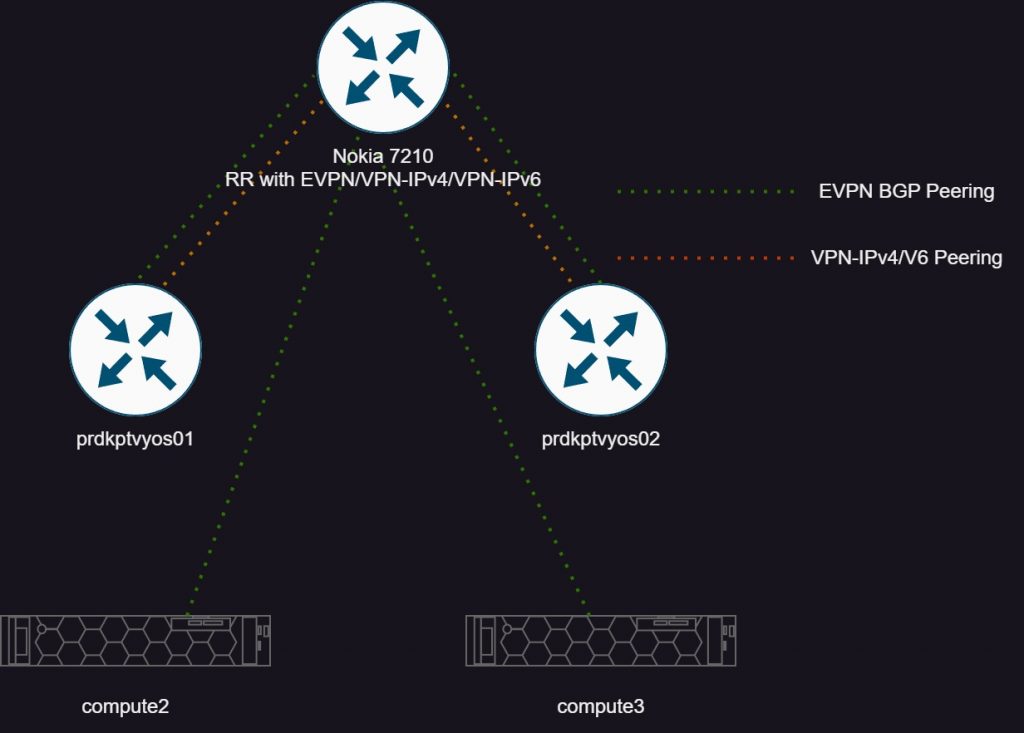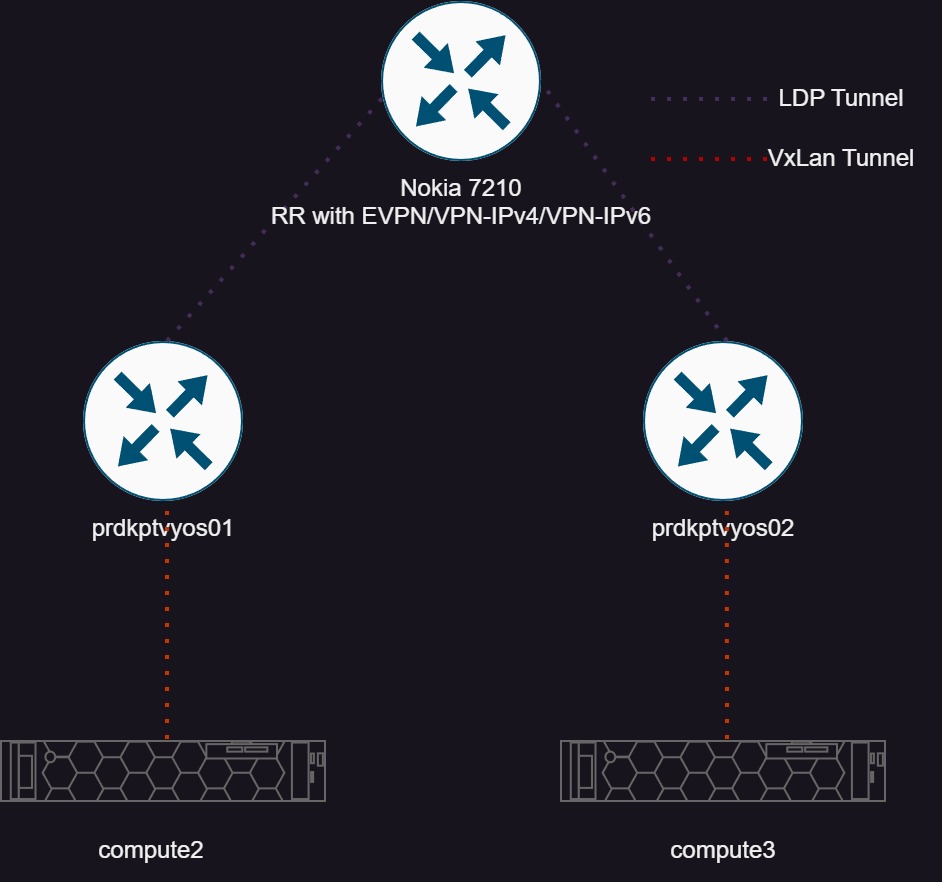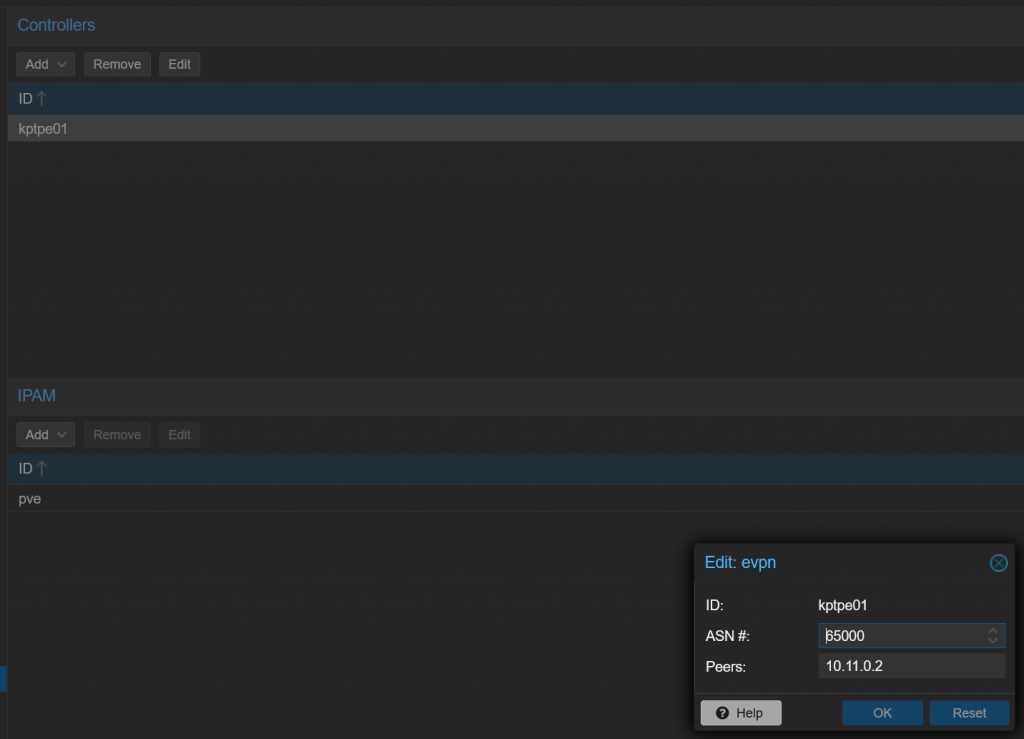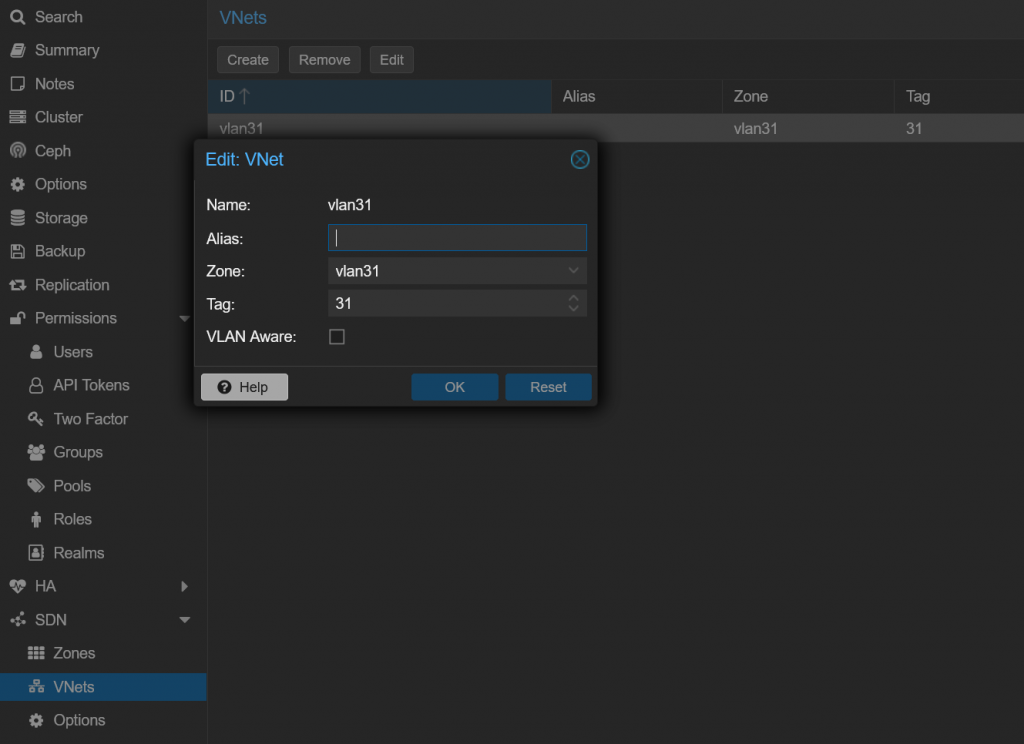With Proxmox 8, and production support of software defined networking, I started to take a harder look at what is possible.
From my understanding, this feature is built on FRR. In this blog, I am looking to take an unconventional approach at using this. From the Proxmox documentation, most of what this feature seems to be used for is networking nodes together which could be over a WAN etc. There are limited options that are available in the GUI, which of course is all you need for this feature to work. I wanted to see what was happening under the hood, and expand on this by having networking features outside of just the hosts too.
Ideally, my setup would consist of VXLAN tunnels terminating on a router, where I have a layer 3 gateway within a VRF. Problem is, while the 7210 supports EVPN, it only supports transport over EVPN-MPLS. Most every opensource project that I have found only supports VXLAN. So my idea was then to use Vyos in the middle, which can terminate the VXLAN tunnels from the Proxmox nodes, and then route from a VRF, to another VRF on the 7210 via MPLS.
Topology


The first picture I’m depicting the control plane of this setup. I am using a Nokia 7210 as a route reflector with several different address families. EVPN for the Proxmox nodes, and EVPN/VPN-IPv4/v6 towards Vyos. More on VPN-IPv6 though, as sadly ran into some unresolved issues.
The second pictures shows the transport tunnels. Simply, VXLAN from Proxmox to Vyos ( It would be full mesh, I neglected to draw it here) and LDP tunnels to the 7210.
Proxmox Configuration
There are some prerequisites that are all covered in the Proxmox documentation in chapter 12. All of these settings are under Datacenter >SDN. First let’s setup a “controller” which is really just defining an external router which will run the EVPN protocol. Under options, add a EVPN controller.

Here simply give it a name, ASN, and peer IP. Then on my router config, I defined a peer group and a cluster id, which means this peer group will act as a route reflector:
A:KPTPE01>config>router>bgp# info
----------------------------------------------
group "iBGP-RR"
family ipv4 vpn-ipv4 evpn
cluster 10.11.0.2
peer-as 65000
advertise-inactive
bfd-enable
neighbor 192.168.254.13
description "compute3"
exit
neighbor 192.168.254.18
description "compute2"
exit
exitIf all goes well, then the peer should come up:
192.168.254.13
compute3
65000 138929 0 04d19h46m 1/0/35 (Evpn)
139268 0
192.168.254.18
compute2
65000 138099 0 04d19h04m 1/0/35 (Evpn)
138432 0 Next, need to define a zone. Proxmox gives this as a definition of “A zone defines a virtually separated network. Zones are restricted to specific nodes and assigned permissions, in order to restrict users to a certain zone and its contained VNets.” In my case, I’m using this to define the vxlan tunnel, and it’s endpoints, which end up being my two vyos instances.

Last thing is to create a vnet. The vnet will be what VMs are actually attached to, and to create a broadcast domain. This config is simple, basically tying together a zone and give it a name a tag, which the tag ends up being the VNI.

Exploring the details
Looking on the Nokia, we can look at what the include multicast routes. As a quick overview, inclusive multicast routes are what are advertised between routers to announce the service. If two peers have RTs and a VNI match, they can build a VXLAN tunnel and exchange data.
A:KPTPE01# show router bgp routes evpn inclusive-mcast rd 192.168.254.18:2 hunt
===============================================================================
BGP Router ID:10.11.0.2 AS:65000 Local AS:65000
===============================================================================
Legend -
Status codes : u - used, s - suppressed, h - history, d - decayed, * - valid
l - leaked, x - stale, > - best, b - backup, p - purge
Origin codes : i - IGP, e - EGP, ? - incomplete
===============================================================================
BGP EVPN Inclusive-Mcast Routes
===============================================================================
-------------------------------------------------------------------------------
RIB In Entries
-------------------------------------------------------------------------------
Network : N/A
Nexthop : 192.168.254.18
From : 192.168.254.18
Res. Nexthop : 192.168.254.18
Local Pref. : 100 Interface Name : vlan1
Aggregator AS : None Aggregator : None
Atomic Aggr. : Not Atomic MED : None
AIGP Metric : None
Connector : None
Community : bgp-tunnel-encap:VXLAN target:65000:31
Cluster : No Cluster Members
Originator Id : None Peer Router Id : 192.168.254.18
Flags : Valid Best IGP
Route Source : Internal
AS-Path : No As-Path
EVPN type : INCL-MCAST
ESI : N/A
Tag : 0
Originator IP : 192.168.254.18 Route Dist. : 192.168.254.18:2
Route Tag : 0
Neighbor-AS : N/A
Orig Validation: N/A
Add Paths Send : Default
Last Modified : 04d19h19m
-------------------------------------------------------------------------------
PMSI Tunnel Attribute :
Tunnel-type : Ingress Replication Flags : Leaf not required
MPLS Label : VNI 31
Tunnel-Endpoint: 192.168.254.18 First we can see from the communities, the encapsulation is VXLAN, and the route target. Also then the VNI, which is the tag we picked as in “31” in this case. If this router supported vxlan, we would be good to go configuring a VPLS service with VXLAN encapsulation. But some more here, and where would the fun be then?
Vyos Configuration
I will keep expanding on this, but for now the relevant configuration for the VXLAN side of this communication.
#This is the VXLAN termination interface in the same L2 as the hypervisors
ethernet eth1 {
address 192.168.254.137/24
hw-id bc:24:11:51:9c:48
mtu 9000
#Routed interface towards 7210
vif 32 {
address 10.0.0.7/31
mtu 9000
}
}
loopback lo {
address 10.11.0.137/32
}
vxlan vxlan31 {
ip {
enable-directed-broadcast
}
mtu 9000
parameters {
nolearning
}
port 4789
source-address 192.168.8.167
vni 31
}
}
protocols {
bgp {
address-family {
l2vpn-evpn {
advertise-all-vni
advertise-svi-ip
vni 31 {
route-target {
both 65000:31
}
}
}
}
#7210 RR client
neighbor 10.11.0.2 {
address-family {
ipv4-vpn {
}
l2vpn-evpn {
}
}
peer-group iBGP-RR-PE
}
#7210 RR Client
neighbor fc00::2 {
address-family {
ipv6-vpn {
}
}
remote-as 65000
}
parameters {
router-id 10.11.0.137
}
peer-group iBGP-RR-PE {
remote-as 65000
}
system-as 65000
}
#IGP towards 7210 and enable LDP
isis {
interface eth1.32 {
network {
point-to-point
}
}
interface lo {
passive
}
level level-1-2
metric-style wide
net 49.6901.1921.6800.0167.00
}
mpls {
interface eth1.32
ldp {
discovery {
transport-ipv4-address 10.11.0.137
}
interface eth1.32
router-id 10.11.0.137
}
}
}I tried to comment the import parts of the config, and to provide it all with examples. At a high level ethernet eth1 is the interface in the same vlan as the hypervisors to send vxlan traffic between the two. Ethernet1.32 is a point to point interface (just being transported over a vlan in my network) to the 7210 to run LDP over.
VPN-IPv4 Configuration
Now turning focus to the other side of Vyos, the mpls/vpn-ipv4 configuration. To recap the traffic flow will look as such:
Proxmox hypervisor <—VXLAN-> vyos (with L3 gateway for VXLAN service) <—MPLS/LDP —> 7210 with a VPRN service
high-availability {
vrrp {
group vxlan31 {
address 172.16.0.1/24 {
}
hello-source-address 172.16.0.2
interface br1
peer-address 172.16.0.3
priority 200
vrid 31
}
}
}
interfaces {
bridge br1 {
address 172.16.0.2/24
member {
interface vxlan31 {
}
}
mtu 9000
vrf test-vprn
}
vxlan vxlan31 {
ip {
enable-directed-broadcast
}
mtu 9000
parameters {
nolearning
}
port 4789
source-address 192.168.254.137
vni 31
}
vrf {
name test-vprn {
protocols {
bgp {
address-family {
ipv4-unicast {
export {
vpn
}
import {
vpn
}
label {
vpn {
export auto
}
}
rd {
vpn {
export 10.11.0.137:231
}
}
redistribute {
connected {
}
}
route-map {
vpn {
export export-lp200
}
}
route-target {
vpn {
both 65000:231
}
}
}
}
system-as 65000
}
}
table 231
}
vrf {
name test-vprn {
protocols {
bgp {
address-family {
ipv4-unicast {
export {
vpn
}
import {
vpn
}
label {
vpn {
export auto
}
}
rd {
vpn {
export 10.11.0.137:231
}
}
redistribute {
connected {
}
}
route-target {
vpn {
both 65000:231
}
}
}
}
system-as 65000
}
}
table 231
}Few comments on the Vyos config.
- Using VRRP to provide gateway redundancy between the two vyos instances for a gateway. This way if a instance goes down, the other vyos instance will still provide a valid gateway.
- Bridge interface is created with the members of the vxlan31 interface, which is what defines the VNI parameters
- Then the vrf configuration
- Most import is defining the route target, redistribute the local interfaces, route distinguisher and to import/export using vpn routes.
Now the 7210:
A:KPTPE01# configure service vprn 231
A:KPTPE01>config>service>vprn# info
----------------------------------------------
route-distinguisher 65000:231
auto-bind-tunnel
resolution any
exit
vrf-target target:65000:231
interface "vlan31" create
address 172.16.1.1/24
sap 1/1/25:31 create
ingress
exit
egress
exit
exit
exit
no shutdownOn the Nokia side, a little more simple as we are only focused with the VPN-IPv4 side of things here
- RD and RT is defined
- I created a L3 interface here just to have something to route to outside the interface in vyos
Review and Checks
To close out this part, let’s run some show commands and make sure the environment is ready to support some clients.
*A:KPTPE01# show router bgp summary
===============================================================================
BGP Router ID:10.11.0.2 AS:65000 Local AS:65000
===============================================================================
BGP Summary
===============================================================================
Neighbor
Description
AS PktRcvd InQ Up/Down State|Rcv/Act/Sent (Addr Family)
PktSent OutQ
-------------------------------------------------------------------------------
10.11.0.137
prdkptvyos01
65000 21466 0 06d09h28m 1/1/312 (VpnIPv4)
21947 0 4/0/40 (Evpn)
10.11.0.140
prdkptvyos02
65000 10 0 00h02m24s 1/1/313 (VpnIPv4)
213 0 5/0/45 (Evpn)
192.168.254.13
compute3
65000 323110 0 11d05h15m 1/0/40 (Evpn)
326755 0
192.168.254.18
compute2
65000 322278 0 11d04h34m 1/0/40 (Evpn)
325924 0
-------------------------------------------------------------------------------
*A:KPTPE01# show router ldp discovery
===============================================================================
LDP IPv4 Hello Adjacencies
===============================================================================
Interface Name Local Addr State
AdjType Peer Addr
-------------------------------------------------------------------------------
to-devkptvyos01 10.11.0.2:0 Estab
link 10.11.0.137:0
to-devkptvyos02 10.11.0.2:0 Estab
link 10.11.0.140:0
-------------------------------------------------------------------------------
*A:KPTPE01# show router tunnel-table
===============================================================================
IPv4 Tunnel Table (Router: Base)
===============================================================================
Destination Owner Encap TunnelId Pref Nexthop Metric
-------------------------------------------------------------------------------
10.11.0.137/32 ldp MPLS 65542 9 10.0.0.7 20
10.11.0.140/32 ldp MPLS 65541 9 10.0.0.9 20
-------------------------------------------------------------------------------
Flags: B = BGP backup route available
E = inactive best-external BGP route
===============================================================================
A:KPTPE01>config>service>vprn# show router 231 route-table protocol bgp-vpn
===============================================================================
Route Table (Service: 231)
===============================================================================
Dest Prefix[Flags] Type Proto Age Pref
Next Hop[Interface Name] Metric
-------------------------------------------------------------------------------
172.16.0.0/24 Remote BGP VPN 00h26m19s 170
10.11.0.140 (tunneled) 0
-------------------------------------------------------------------------------vyos@devkptvyos01:~$ show mpls ldp binding
AF Destination Nexthop Local Label Remote Label In Use
ipv4 10.11.0.2/32 10.11.0.2 16 131071 yes
ipv4 10.11.0.137/32 0.0.0.0 imp-null - no
ipv4 10.11.0.140/32 10.11.0.2 18 131045 yes
vyos@devkptvyos01:~$ show mpls ldp neighbor
AF ID State Remote Address Uptime
ipv4 10.11.0.2 OPERATIONAL 10.11.0.2 6d10h56m
#View EVPN Type 2 Inclusive multicast routes
vyos@devkptvyos01:~$ show bgp vni all
VNI: 31
BGP table version is 1041, local router ID is 10.11.0.137
Status codes: s suppressed, d damped, h history, * valid, > best, i - internal
Origin codes: i - IGP, e - EGP, ? - incomplete
EVPN type-1 prefix: [1]:[EthTag]:[ESI]:[IPlen]:[VTEP-IP]:[Frag-id]
EVPN type-2 prefix: [2]:[EthTag]:[MAClen]:[MAC]:[IPlen]:[IP]
EVPN type-3 prefix: [3]:[EthTag]:[IPlen]:[OrigIP]
EVPN type-4 prefix: [4]:[ESI]:[IPlen]:[OrigIP]
EVPN type-5 prefix: [5]:[EthTag]:[IPlen]:[IP]
Network Next Hop Metric LocPrf Weight Path
#192.168.254.13 and .18 are proxmox hosts
*>i[3]:[0]:[32]:[192.168.254.13]
192.168.254.13 100 0 i
RT:65000:31 ET:8
*>i[3]:[0]:[32]:[192.168.254.18]
192.168.254.18 100 0 i
RT:65000:31 ET:8
#The two vyos routers
*> [3]:[0]:[32]:[192.168.254.137]
192.168.254.137 32768 i
ET:8 RT:65000:31
*>i[3]:[0]:[32]:[192.168.254.140]
192.168.254.140 100 0 i
RT:65000:31 ET:8
vyos@devkptvyos01:~$ show ip route vrf test-vprn
Codes: K - kernel route, C - connected, S - static, R - RIP,
O - OSPF, I - IS-IS, B - BGP, E - EIGRP, N - NHRP,
T - Table, v - VNC, V - VNC-Direct, A - Babel, F - PBR,
f - OpenFabric,
> - selected route, * - FIB route, q - queued, r - rejected, b - backup
t - trapped, o - offload failure
VRF test-vprn:
C>* 172.16.0.0/24 is directly connected, br1, 6d11h23m
B> 172.16.1.0/24 [200/0] via 10.11.0.2 (vrf default) (recursive), label 131056, weight 1, 6d11h22m
* via 10.0.0.6, eth1.32 (vrf default), label 131071/131056, weight 1, 6d11h22mI know this is a ton of data above, but what I’m trying to show is that we have the expected inclusive multicast EVPN routes from Proxmox and the Vyos instances. Then there is MPLS/LDP connectivity between vyos and the 7210. Finally in the route tables, we have a route bidirectionally between the two so in theory if hosts were to communicate between the two it should work.
This is all I have for this post. The next post I will actually enable VMs on these networks, and show the connectivity.